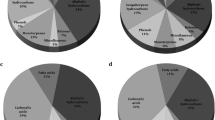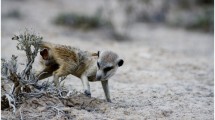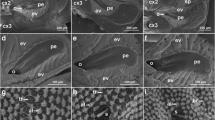Abstract
A characterization at a molecular level of the chemical composition of the secretions of the two pairs of paracloacal glands and of the sternal sebum of the brushtail possum (Trichosorus vulpecula Kerr) has been undertaken with a view to evaluating the potential of volatile “pheromone” components as species-specific attractants for use in novel baiting systems. Particular attention has been given to the respective fatty acid fractions produced by chemical hydrolysis, since these are believed to be the products of postemission microbial degradation (fermentation) of the secretions. In all instances, the highly complex distribution of the constituents present in these organic components of the secretions were shown to be virtually identical in adult males and females. A unique suite of low-molecular-weight branched-chain carboxylic acids has been shown to be produced by chemical degradation of the holocrine (oil-secreting) gland secretion. This odor signature is suggested to function as a unique “scenting-the-habitat” pheromone that might act as an attractant to all members of the species.
Similar content being viewed by others
References
Abrahamsson, S., Ställbeg-Stenhagen, S., andStenhagen, E. 1963. The higher saturated branched-chain acids, pp. 41, in R.T. Holman and T. Malkin (eds.). The Chemistry of Fats and Other Lipids, Vol. 7, Part 1, Pergamon Press, Oxford.
Albone, E.S. 1984. Mammalian Semiochemistry—The Investigation of Chemical Signals between Mammals. John Wiley & Sons, Chichester, U.K.
Albone, E.S., andPerry, G.C. 1976. Anal sac secretion of the red fox,Vulpes vulpes; volatile fatty acids and diamines: Implications for a fermentation hypothesis of chemical recognition.J. Chem. Ecol. 2:101.
Bannon, C.D., Breen, G.J., Craske, J.D., Hai, N.T., Harper, N.L., andO'Rourke, K.L. 1982. Analysis of fatty acid methyl esters with high accuracy and reliability.J. Chromatogr. 247:71.
Belitz, H.-D., andGrosch, W. 1986. Food Chemistry. Springer-Verlag, Berlin. p. 147.
Biggins, J.G. 1979. Olfactory communication in the brushtailed possum. Ph.D. Thesis. Monash University, Melbourne.
Boag, B., andMlotkiewicz, J.A. 1991. Evaluation of an odour derived from lion faeces on the behaviour of wild rabbits.Tests Agrochem. Cultiv. 0(12):18.
Bolliger, A., andHardy, M.H. 1944. The sternal integument ofTrichosorus vulpecula.Proc. R. Soc. N.S.W. 78:122.
Bolliger, A., andWhitten, W.K. 1948. The paracloacal (anal) glands ofTrichosorus vulpecula.J. Proc. R. Soc. N.S.W. (Australia) 82:36–43.
Buisson, D.H., Body, D.R., Dougherty, G.J., Eyres, L., andVlieg, P. 1982. Oil from deep water fish species as a substitute for sperm and jojoba oils.J. Am. Oil Chem. Soc. 59:390.
Christie, W.W. 1983. Esterification of fatty acids in adipose tissue, p. 111,in Fats for the Future. Proceedings, International Conference on Oils, Fats and Waxes. Duromark Publishers, Auckland.
Clapperton, B.K., andWoolhouse, A.D. 1991. Development of a long-lasting synthetic mustelid lure: Final report. Contract Report prepared for Directory (Science and Research), Department of Conservation, New Zealand.
Crombie, L., andHarper, S.H. 1950a. Stereochemical studies of olefinic compounds. Part II. Ring scission of 2-1'-halogenoalkyltetrahydrofurans and 3-halogeno-2-alkyltetrahydropyrans as a route to alk-4-en-1-ols of known configuration and as a method of chain extension by five methylene groups.J. Chem. Soc. 1950:1707;idem.,Crombie, L., andHarper, S.H. 1950b. Stereochemical studies of olefinic compounds. Part III. Scission of 3-halogeno-2-alkyltetrahydrofurans as a route to 3-en-1-ols of known configuration and as a method of chain extension by four methylene groups.J. Chem. Soc. 1950:1714.
Davey, C.L., Johnstone, P.R., andSwan, J.E. 1983. New Zealand tallow—its potential, p. 20,in Fats for the Future, Proceedings, International Conference on Oils, Fats and Waxes. Duromark Publishers, Auckland.
Gorman, M.L. 1976. A mechanism for individual recognition by odour inHerpestes auropunctatus.Anim. Behav. 24:141.
Gorman, M.L., Jenkins, D., andHarper, R.J. 1978. The anal scent sacs of the otter (Lutra lutra).J. Zool. London 186:463.
Gorman, M.L., andTrowbridge, B.J. 1989. The role of odour in the social lives of carnivores, pp. 57–88,in J.L. Gittleman (ed.). Carnivore Behaviour, Ecology and Evolution, Cornell, University Press, Itacha, New York.
Innes, J., andFrampton, C. 1991. Identification of lures and quantifying their action in attracting possums to baits. Forest Research Institute Contract Report FWE 91/45.
Kydonieus, A.F., andBeroza, M. (eds.). 1982. Insect Suppression with Controlled Release Pheromone Systems. CRC Press, Boca Raton, Florida.
Milburn, A.H., andTruter, E.V. 1954. The components of wool wax. Part II. Synthesis of the acids and alcohols of the iso and (+)-anteiso series.J. Chem. Soc. 1954:3344.
Morgan, D.R. 1982. Field acceptance of non-toxic and toxic baits by populations of the brushtail possum (Trichosorus vulpecula Kerr).N.Z.J. Ecol. 5:36.
Müller-Schwarz, D. 1990. Leading them by their noses: Animal and plant odours for managing vertebrates, p. 585,in D.W. McDonald, D. Müller-Schwarz and S.E. Natywczuk (eds.). Chemical Signals in Vertebrates 5. Oxford University Press, New York.
Nicolaides, N. 1974. Skin lipids: Their biochemical uniqueness.Science 186:19.
Olafsdottir, G., Steinke, J.A., andLindsay, R.C. 1985. Quantitative performance of a simple Tenax GC absorption method for use in the analysis of aroma volatiles.J. Food Sci. 50:1431.
Ridgway, R.L., Silverstein, R.M., andInscoe, M.N. (Eds.). 1990. Behaviour-Modifying Chemicals for Insect Management, Applications of Pheromones and Other Attractants. Marcel Dekker, New York.
Russell, E.M., 1987. Metatherians: order Marsupialia, p. 45, in R.E. Brown and D.W. Macdonald (eds.). Social Odours in Mammals. Oxford University Press, London.
Sarkar, M.P., andBramachary, R.L. 1991. Short chain free fatty acids as putative pheromones in the marking fluid of the tiger.J. Indian Chem. Soc. 68:225–256.
Sugiyama, T., Sasada, H., Masaki, J., andYamashita, K. 1981. Unusual fatty acids with specific odour from mature male goat.Agric. Biol. Chem. 45:2655–2657.
Sullivan, T.P., andCrump, D.R. 1984. Influence of mustelid scent-gland compounds on suppression of feeding by snowshoe hares (Lepus americanus).J. Chem. Ecol. 10:1809–1821.
Sullivan, T.P., Crump, D.R., Weiser, H., andDixon, E.A. 1988. Predator odours and their potential role in managing pest rodents and rabbits.Proc. Vertebr. Pest Conf. 13:145–150.
Sullivan, T.P., Crump, D.R., Weiser, H., andDixon, E.A. 1990a. Comparison of release devices for stoat (Mustela erminea) semiochemicals used as montane vole (Microtus montanus) repellents.J. Chem. Ecol. 16:951–957.
Sullivan, T.P., Crump, D.R., Weiser, H., andDixon, E.A. 1990b. Response of pocket gophers (Thomomys talpoides) to an operational application of synthetic semiochemicals of stoat (Mustela erminea).J. Chem. Ecol. 16:941–949.
Thomson, J.A, andPears, F.N. 1962. The functions of the anal glands of the brushtail possum.Vict. Nat. (Aust.) 78:306.
Tyndale-Biscoe, H. 1975. Life of Marsupials, Edward Arnold Publishers, London. p. 162.
Vogler, K., andChopard-dit-Jean, L.H. 1960. Synthesis of dipeptide-fragments with (+)-isopelargonic acid.Helv. Chim. Acta 43:279.
Author information
Authors and Affiliations
Rights and permissions
About this article
Cite this article
Woolhouse, A.D., Weston, R.J. & Hamilton, B.H. Analysis of secretions from scent-producing glands of brushtail possum (Trichosorus vulpecula Kerr). J Chem Ecol 20, 239–253 (1994). https://doi.org/10.1007/BF02064434
Received:
Accepted:
Issue Date:
DOI: https://doi.org/10.1007/BF02064434




